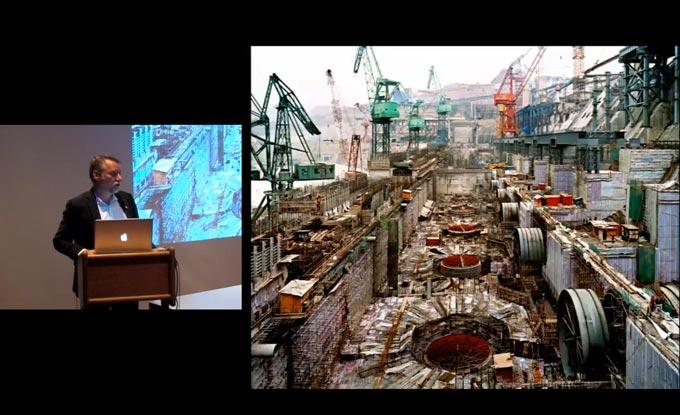By Emily Craig-Evans
For the first time in 15 years, Ryerson alumnus and renowned photographer Edward Burtynsky returned to his alma mater to speak publicly. At the School of Image Arts on November 27, Burtynsky shared the road to his success, his latest works and the evolution of his worldview since beginning his career in the early ‘80s.
Katy McCormick, School of Image Arts assistant professor and long-time friend of Burtynksy, credited the marvel of Burtynsky’s landscape and industrial photography to his “desire to understand things from the inside out.”
Burtynsky said that photography had not yet found recognition in the art world as a medium of equal value or potential as traditional mediums when he began his bachelor of applied arts at Ryerson in the late ’70s. He didn’t know of anyone who supported themselves solely on the proceeds of their photography. Now, Burtynsky does just that.
Renowned for his role in film projects “Manufactured Landscapes” and the recent “Watermark,” Burtynsky began by capturing large landscapes in black and white during a peak in urban street photography popularity. He said he was told he was pursuing something that would not go anywhere, that the “celebration of landscape had been defined and sailed on.”
Burtynsky began to consider how he was approaching his subject. His focus shifted from untouched pristine landscapes to human shaped and marred landscapes. His work became not a celebration of nature, but a subtle critique of human enterprise. Burtynsky’s mission became connecting humans to the landscapes which have essentially provided the urban existence. His capturing of mines, quarries, tailings, and oil sands shows how humans have become the “fifth element” shaping the planet.
But it’s the subtlety of Burtynsky’s critique that makes his work so powerful for many. He does not alter his images to emphasize the destruction of landscapes. He allows the viewer to come to their own conclusions about what is being presented. The massive scale of his photography creates a sense of awe and deafening inner calm; perhaps even a sense of connectedness or belonging to the human race.
Burtynsky’s latest work, “Watermark,” focused particularly on how humans have shaped water, and inversely, how water has shaped us.
“We have a deep human desire to be in the presence of water,” he said.
He traveled the globe with filmmakers Jennifer Baichwal and Nick de Pencier to capture the stunning symmetry of agricultural fields with massive irrigation systems supported by ancient aquifers; the unprecedented scale of the Three Gorges Dam; floating aquaculture villages; and depleted lake and river beds, and more.
Edward Burtynsky is a Ryerson alumnus success story. During last week’s lecture, it was clear Burtynsky has won the admiration of many current Image Arts students. Now that “Watermark” is finished, one student wanted to know what’s next for Burtynsky.
Reading, he said. It’s time for a break.










Leave a Reply